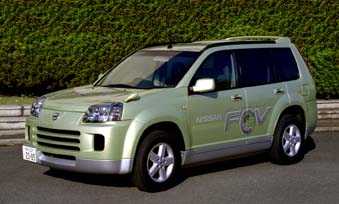Terror's Next Target
Attacks on the West's oil and gas infrastructure -- from production facilities to pipelines and tankers -- are likely to be the next "mega" target of terrorists, and could wreak havoc with the world's economy, according to an in-depth IAGS analysis of the susceptibility of the energy industry featured in the latest Journal of International Security Affairs (Winter 2004).
Minding Its Business
Saudi Arabia, which has demonstrated its willingness to use its vast oil reserves as a foreign policy tool, has not acted to aid U.S. efforts to rebuild Iraq.
Fencing in looters and saboteurs in Iraq
Too many people in and outside of Iraq are hoping to deny Iraq a better future through a campaign of sabotage and plunder of the country's neglected oil facilities. The problem, and possible solutions.
Energy security and liquefied natural gas
Demand for natural gas has increased as have the security vulnerabilities presented by liquefied natural gas terminals and tankers.
Under the Radar
Oil, terrorism and drugs intermingle in Colombia
Seventy U.S. Special Forces soldiers are training Colombians to protect an oil pipeline.
Japan's struggle to secure future oil supply
Energy dependent Japan looks to Iran for oil, causing tension with the U.S.
Chad-Cameroon pipeline project put to test
Will the pipeline, partially financed by the World Bank, improve the lot of Chad and Cameroon
or exacerbate existing corruption and strife?
Natural resource curse hits São Tomé
A tiny West African country illustrates a well known problem.
On the technology front
Fuel Cell Locomotive for Military and Commercial Railways
An international consortium is developing the world’s largest fuel cell vehicle, a 109 metric-ton, 1 MW locomotive.
Fuel cell power plant installed at NJ Sheraton
A stationary fuel cell will supply 250 kilowatts of electric power as well as heat to the Sheraton Edison
Hotel, accounting for about 25 percent of the hotel's electricity and hot water.
Fuel cell scooters for Europe and China
Palcan's fuel cell powered scooter is designed to address the world's need for a low-end mass transport vehicle.
U.S. Air Force
to get fuel cell bus
Fuel cell powered thirty-foot hybrid bus to be stationed at the Hickam Air Force Base in Hawaii.
IAGS is a publicly supported, nonprofit organization under section 501(c)3 of the Internal
Revenue Code.
IAGS is not
beholden to any industry or political group. We depend on you for
support. If you think what we are doing is worthwhile, please Support
IAGS. All contributions are tax deductible to the full extent allowed by law.
Property of The Institute for
the Analysis of Global Security © 2003. All rights reserved.
Back Issues
|
Nissan leasing fuel-cell vehicles
Nissan Motor Co., Ltd., Japan's second largest automobile manufacturer and the world's fifth, began a limited leasing of its X-TRAIL FCV, a high-pressure hydrogen fueled fuel cell vehicle (FCV). The first vehicle was delivered to oil refiner Cosmo Oil Co. earlier this week in a ceremony held at the JHFC Yokohama-Daikoku Hydrogen Station in Japan. The lease price is 1,000,000 yen/month.
Following the approval of the 2002 model X-TRAIL FCV by the Japanese Minister of Land, Infrastructure and Transport, Nissan conducted repeated driving tests of the vehicle on public roads in Japan. In addition to using the data obtained in those public road tests to make various improvements, Nissan equipped the 2003 model of the X-TRAIL FCV with a host of new technologies to enhance its performance significantly.
The 2003 model X-TRAIL FCV is fitted with a high-power motor that generates maximum power of approximately 85 kW, about 1.5 times more power than the 2002 model, enabling the vehicle to deliver powerful driving performance. The top speed of the vehicle is 145 km/hr. The driving cruising range has also been extended 1.75 times to more than 350 km. The increase was accomplished by adopting Nissan’s Compact Lithium-ion Battery and a fuel cell stack that operates with superior efficiency. Unveiled at the Tokyo Motor Show, the Compact Lithium-ion Battery features high power density, outstanding cooling performance and a compact design. This battery also contributes to a substantial improvement in interior space efficiency as a result of adopting a newly developed thin, laminated cell in place of the conventional cylindrical cell.
Cosmo Oil intends to use data gathered from the hydrogen-powered X-TRAIL FCV to learn more about how the hydrogen supply infrastructure should be configured.
Both Cosmo Oil and Nissan are participating in the Japan Hydrogen & Fuel Cell Demonstration (JHFC) Project. The two companies intend to undertake joint research and development work on hydrogen fueling.
This JHFC project consists of the Demonstration Study of Hydrogen Fueling Facilities for Fuel Cell Vehicles, being conducted by the Engineering Advancement Association of Japan, and the Fuel Cell Demonstration Program, being conducted by the Japan Automobile Research Institute. These demonstration activities are included in a support project for "empirical and other research on solid high-polymer fuel cell systems" sponsored by the Japanese Ministry of Economy, Trade and Industry.

|
| Nissan's 2003 model X-TRAIL FCV |
Also see:
San Francisco and Honda to partner on fuel cell car program
Top
|
 Energy Security
Prepared by the Institute for the Analysis of Global
Security
Energy Security
Prepared by the Institute for the Analysis of Global
Security